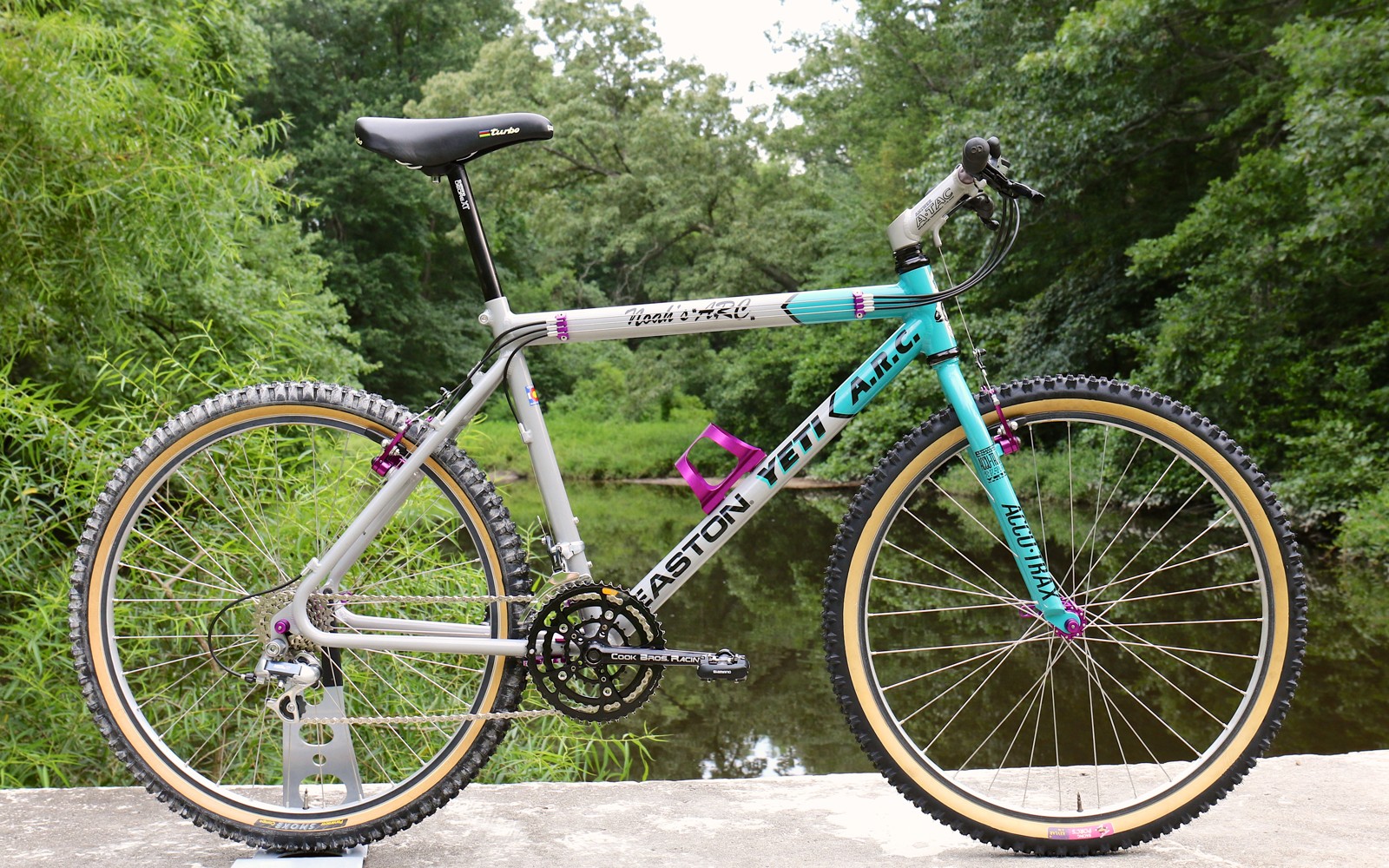
Retro 1992 Yeti A.R.C. | Image source: yeticycles.com
Mountain biking is a relatively new cycling discipline when compared to cycling in general. While the first bikes were built in the early 1800s, almost 150 years went by before we saw the early iterations of mountain bikes (MTB).
In the relatively short time it’s been around, MTB technology has progressed massively, going from crude cruiser conversions to the innovative best full-suspension mountain bikes we see today.
In this article, we’ll lay out the history of mountain biking and discover some of the key players and brands that contributed to its development into one of cycling’s most popular disciplines, both competitively and for leisure.
What Is Mountain Biking?
Mountain biking is a broad discipline with many variations in where and what you ride. MTB sub-disciplines include Enduro, Downhill, Cross-Country (XC), Free Ride, Dirt Jump, and more.
MTB routes include singletrack and double-track mountain trails, backcountry roads, forest paths, bike park courses, gravel paths, fire roads, and ski parks.
Mountain bikes are purpose-built bikes designed for these environments. There are many categories of bikes, and these continue growing as the scene incorporates more riding styles and routes.
While the componentry varies hugely across MTB disciplines, it’s generally more robust and durable than road bike components. For example, MTBs have wider tires with thicker rubber, stronger wheels and frame materials, more powerful brakes, and suspension.
A broad definition of mountain biking is any off-road riding on trails that are too rough for a traditional road or urban bike.
Mountain biking requires a more diverse skillset than other riding styles. From descending incredibly steep gradients at high speeds to performing aerial maneuvers and jumps, mountain bikers need a broad and developed level of technique to be effective.
Origins of Modern Mountain Biking
As we’ll discover later, the birthplace of modern mountain biking is generally regarded to be the western USA. However, riding off-road on hilly or mountainous terrain and fields was part and parcel of riding a bike in the late 1800s and early 1900s.
Before the widespread use of the automobile, there were very few, if any, paved roads like the ones we have today. Instead, cyclists had to cross grassy fields, forest and mountain trails, and chunky gravel roads to get where they needed to go.
One of the first recorded examples of bikes used for off-road-specific riding was within the United States army in 1897. Lieutenant James A. Moss led a group of soldiers 1900 miles from Fort Missoula, Montana, to St. Louis, Missouri, on safety bicycles modified for backcountry terrain.
Meanwhile, in Europe in the early 1900s, road racing cyclists started the early iterations of cyclocross riding and racing, which involved riding across muddy farms and grassy fields between towns to maintain fitness in the off-season. Races of this type spread across Europe in the following decades before the sport was officially recognized in 1940 by the Union Cycliste Internationale (UCI).
One of the first recorded examples of bikes used for off-road-specific riding was within the United States army in 1897.
Throughout the first half of the 20th century, off-road riding continued worldwide, with minor equipment improvements and the popularization of sports like cyclocross.
In the 1950s, you had the creation of off-road cycling clubs like ‘The Rough Stuff Fellowship’ in the UK and members from the Velo Cross Club Parisien taking on mountain biking-style rides using bikes modified to handle off-road terrain.
1960 to 1980, USA: A Critical Period in Mountain Biking History
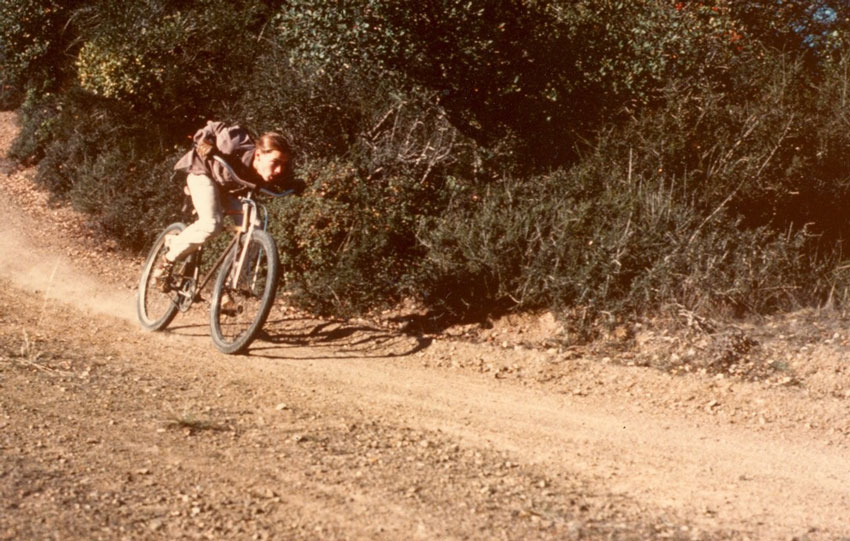
Early mountain biker storming a descent on a klunker-like bike. | Image credit: Charlie Kelly, Sonic.net
There were undoubtedly many hotspots for off-road riding and racing around the world from 1960 to 1980. However, none were as influential as the western United States, particularly California.
- 1960 to 1970 – The Larkspur Canyon Gang
In the western United States, around the 1960s, off-road riding was increasing in popularity in a few isolated bubbles of cycling enthusiasts.
One of the pioneering groups of riders was the Larkspur Canyon Gang, tackling Larkspur Canyon and Mt. Tamalpais trails with single-speed balloon-tire bikes.
This group became well-known amongst local cyclists and later inspired road bike riders from the Velo Club Tamalpais to begin modifying their old bikes for capability on the local trails.
- Early 1970s – Klunker bikes start to take shape, modified for tackling more extreme terrain
In Colorado, riders of the trails around Crested Butte were also modifying their klunker bikes for enhanced off-road performance, allowing for more adventurous riding.
In California, Russ Mahon of Cupertino tried to gain the upper hand in local cyclocross races by adding gears and drum brakes to his klunker bike. Cyclocross had begun to take off after its official introduction to the US in 1963.
- 1976 – Repack races begin, organized by Fred Wolf and Charlie Kelly
With more capable equipment, off-road riding became more extreme. From 1976 to ’84, downhill races called ‘Repack’ began in Marin County, made possible by these modified bikes. They took place on the mountain on the fire roads of Mt. Tamalpais, and the fierce competition among competitors hastened the innovation of off-road bikes.
- 1978 – The first cross-country race
In 1978, the first recorded cross-country mountain bike event was held in Crested Butte, raced on klunkers. However, it would be another 12 years in 1990 when UCI recognized XC as a cycling discipline.
1983 to 1997: A Decade and a Half of Firsts
- 1983 – Mike Synard and Specialized created the first mountain biking team. Marin County riders set up the National Off-Road Bicycle Association (NORBA)
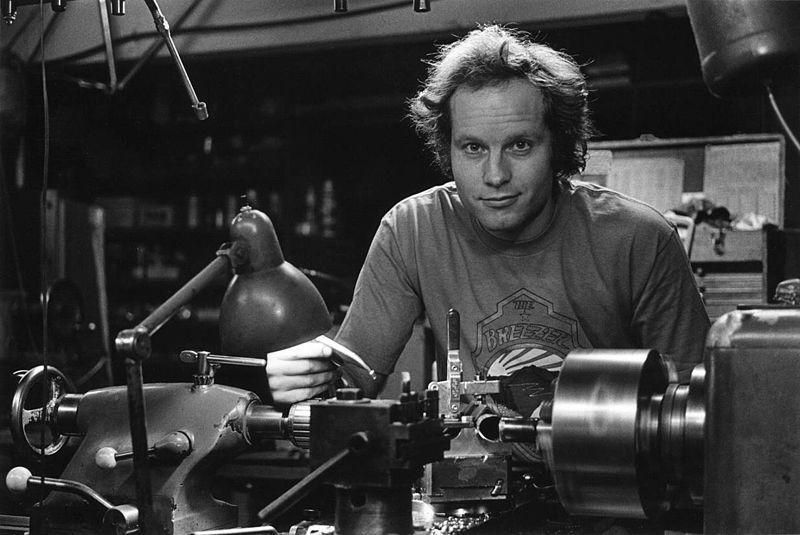
Joe Breeze in 1984, working on early mountain bike designs. | Image credit: Wikipedia
- 1986 – First (non-sanctioned) MTB World Championships goes ahead
Just two years after the final Repack race took place in ’84, the first Mountain Bike World Championships was held. In addition, the longest-running downhill race ‘Laguna Rads’ was first organized in Laguna Beach, California.
- 1988 – First UCI-sanctioned Mountain Bike World Cup series
This XC competition consisted of nine events across North America and Europe.
- 1990 – UCI Mountain Bike World Championships in Durango, Colorado
This was the first UCI-organized World Championships. There were events in Downhill (DH) and XC. North Americans won all the medals in both the men’s and women’s categories.
- 1993 – The first dedicated DH World Cup takes place
This six-race competition was held in Métabief, France, and won by American rider Mike King.
- 1996 – XC Mountain Biking is added to the summer Olympic Games
The 1996 Games were held in the United States, and there was no better time to add the sport of XC mountain biking to the lineup. Bart Brentjens of the Netherlands took the first-ever gold medal.
Evolution of the Mountain Bike
1950 to 1980: The Early Years
It’s difficult to pin down the first bicycle that may be considered a ‘mountain’ bike. The massive number of early tinkerers and contributors makes it impossible to mention all names, but we will try to highlight most of those that laid the foundations for the modern mountain bike.
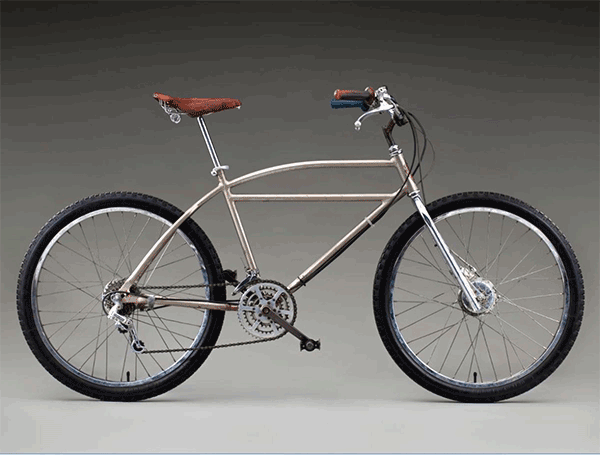
A modified Schwinn Excelsior, an early klunker bike. | Image credit: ESMTB.com
Like mountain bike racing, individuals and groups in the western USA are responsible for many key innovations in the development of modern MTBs. Various groups of cycling enthusiasts in Oregon and California began tinkering with their bikes in a formative period from the early 1950s to the late 1970s.
-
1953 – John Finley Scott builds a mountain bike prototype
John Finley Scott, a sociology professor at UC Davis and cyclists’ rights activist, is understood to have modified an old Schwinn World diamond frame to create his ‘Woodsie’ bicycle. Scott added gears, flat handlebars, knobbly balloon tires, and cantilever brakes to this early MTB prototype.
- 1966 – D. Gwynn builds a trail-specific bicycle in Oregon
In the two decades following Scott’s creation, different groups in California and Oregon were modifying old 30s and 40s balloon-tire bikes for off-road riding, such as the Larkspur Canyon Gang. However, Gwynn may have been the first to use the term ‘Mountain Bicycle’ upon creating his own makeshift MTB.
- 1971 to ’73 – Russ Mahon and The Cupertino Riders modify their bikes to compete in local cyclocross events
This innovative bunch from Saratoga, California, sometimes known as the Morrow Dirt Club, took huge leaps in mountain bike evolution. They experimented with adding thumb shifters, derailleurs, drum brakes, double chainrings, five cog freewheels, and wide handlebars to their old balloon-tire bikes.
- 1974 – Russ Mahon’s group brings the modified bikes to a Mill Valley, CA cyclocross event
At this event, many riders, most notably Gary Fischer, Charlie Kelly, and Joe Breeze of Marin County, competed against the Cupertino Riders and were blown away by the sophistication of these innovative bikes compared to their single-speed klunkers. After this race, these Marin riders began making similar modifications, like adding gears and drum brakes to their bicycles.
- 1976 – Charlie Kelly petitions Craig Mitchell to build a bike for him to race in his Repack events
- 1977 to ’78 – Joe Breeze designs and builds ten mountain bikes
Using high-quality lightweight tubing, old Schwinn frame geometry, 26″ x 2.125″ Uniroyal tires, and Schwinn S2 rims, Joe manufactured the first successful production run of MTBs. Charlie Kelly purchased the second Breezer bike from Joe in 1978.

Early Breezer mountain bike with multiple gears, rim brakes, and a reinforced frame. | Image source: TheProsCloset.com
- 1978 – Mert Lawwill creates and begins producing the Pro Cruiser, the first commercially-sold mountain bike
- 1979 – Charlie Kelly and Gary Fischer hire local frame-builder Tom Ritchey to build some fat-tire bikes
This joint venture eventually led to the creation of MountainBikes, Fischer, and Kelly’s business using Ritchey’s frames. Although the company ultimately failed, it played a significant role in the initial marketing push for mountain bikes.
Across the pond, at the same time, Geoff Apps developed a custom-built lightweight bicycle with 650Bx54 and 700Cx47 Nokia Hakkapeliitta snow tires to handle wet and muddy off-road conditions found in southeast England. Cleland Cycles in the UK continued selling these until 1984.
Key Moments From 1980 to 2012: Mountain Bikes Technology Takes Off
The first mountain bikes were crude compared to their modern-day counterparts. They looked similar to urban bikes but with wider tires, thicker steel tubing, and slightly different geometry.
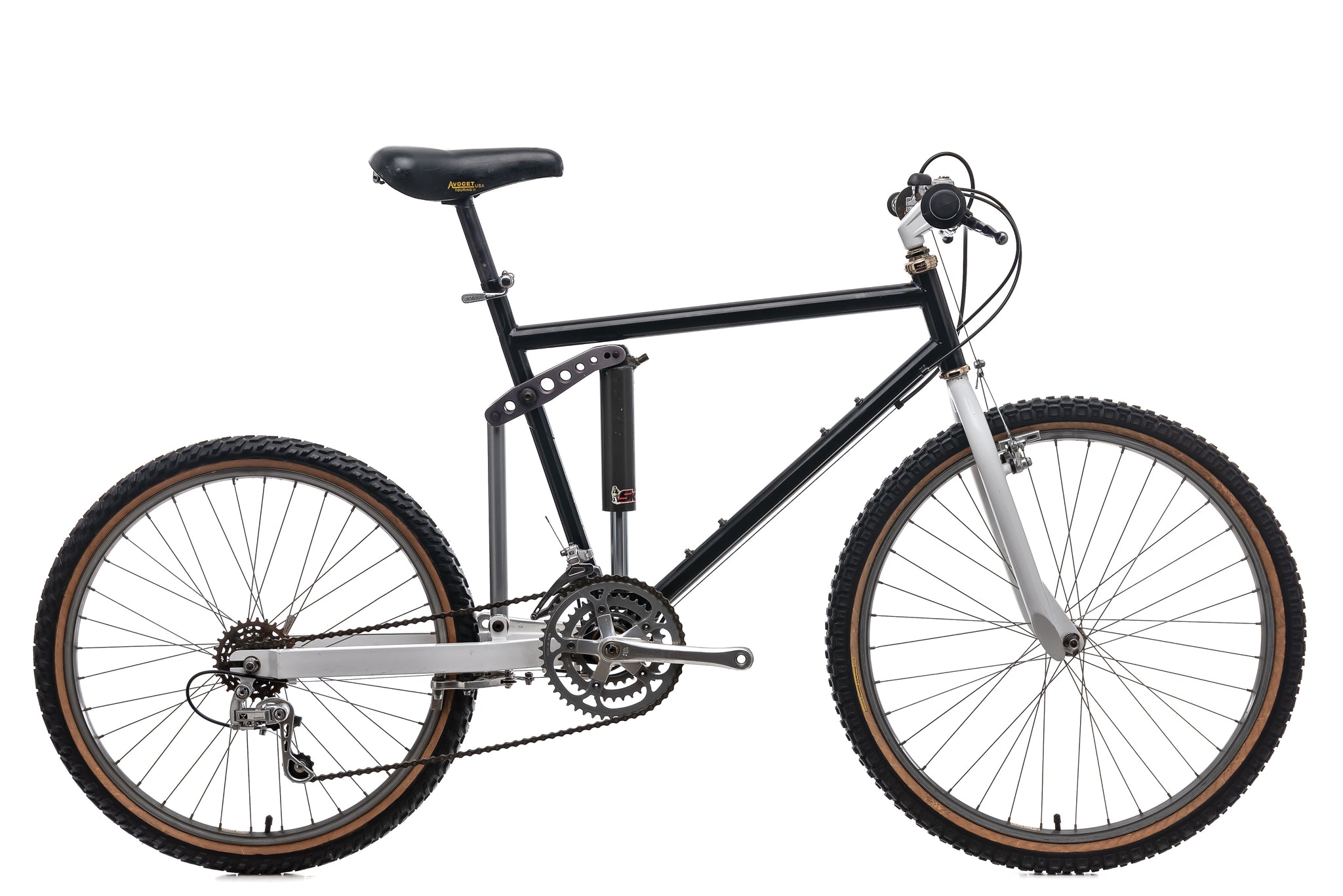
First rear-suspension mullet mountain bike – MCR Descender. The rear suspension was modeled after an MX bike Kawasaki KX250 | Image: TheProsCloset.com
The forks were also wider to fit wide tires, and they used wide flat handlebars for better control on descents. In addition, BMXs inspired some of the parts on early production mountain bicycles.
- 1981 to ’82 – Specialized releases the first mass-marketed mountain bike, and Shimano releases the first Deore groupset
Based on Tom Ritchey’s frame design, Specialized’s Stumpjumper arrives on the market with 500 units total. This bike featured a TIG-welded steel frame, 15 gears (3×5-speed), 26″ wheels, and weighed 29lbs. Around the same time, Uvinega released the first of its Alpina series.
- 1983 – Brian Skinner designs the first rear-suspension mountain bike, built by Victor Vincente
The ‘Descender’ mountain bike was designed for DH races and featured a single-pivot rear suspension design.
- 1984 – Keith Bontrager produces the first lightweight and strong 26″ mountain bike rims, cut from Mavic MA-2 road rims
- 1985 – An updated MCR Descender hits the market
Two years after designing the Descender prototype, Brian Skinner made a limited release of an updated MCR Descender equipped with Shimano parts.
- 1988 – Ibis founder Scot Nicol creates the first mountain bike with carbon in the frame. This model has a steel rear triangle
- 1990 – Doug Bradbury, the founder of Manitou, designs and builds the first suspension fork
This original fork used elastomers that provided roughly 50mm of travel. Elastomers are plastic with elastic properties that act like a spring. That year John Tomac and Juli Furtado used the fork to win the Mountain Biking World Championships XC races.
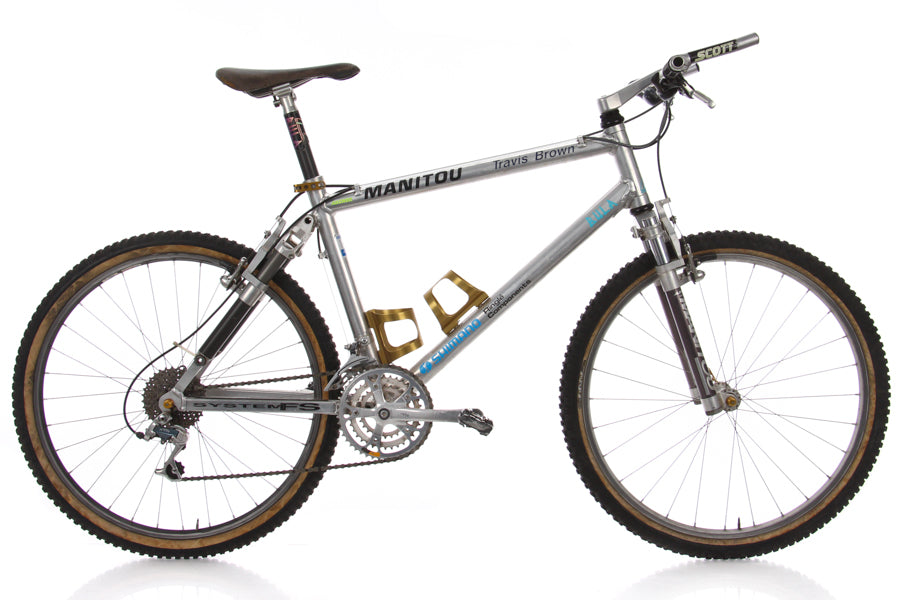
Travis Brown’s Manitou full-suspension mountain bike. Image credit: TheProsCloset
- 1991 – Bradbury designs a dual-suspension bike for Travis Brown to use the following season
This bike had a suspension fork in the front and another in the rear dropouts. In addition, it had one pivot behind the bottom bracket and another at the top of the seatstays so the back end could articulate. However, this was ultimately an ineffective design.
- 1993 – Yeti, one of the early pioneers of full-suspension mountain bikes, designed the ARC for professional rider Missy Giove
This bike had a Manitou 2 fork with a RockShox Judy spring in the left leg. In the rear, the Yeti ARC had a simple single-pivot design and a shock with around 25mm travel. The shock was attached to the frame at two points with custom welded plates, allowing you to modify the geometry and travel based on the position of the shock.
Kestrel Rubicon
- 1995 – Kestrel releases the Rubicon Comp Kamikaze for Kurt Stockton’s DH racing, one of the first carbon full-suspension cross-country bikes
Again, looking vastly different from their modern-day equivalents, downhill bikes of the 1990s had the most travel ever seen on bicycles.
More suspension travel meant that you were less likely to puncture or lose control during a downhill run. However, these shocks couldn’t handle DH racing and weren’t advanced enough to keep the suspension in place when putting the power down in XC.
- 1998 – Myles Rockwell’s Cannondale Fulcrum DH was the most advanced downhill bike at the time ($20.000 – $30,000 to make one)
The Cannondale Fulcrum DH attempted to address the main problem DH riders of the day faced; limiting pedal bob without affecting the suspension performance.
They introduced a complex jackshaft drive system to solve the issue. But unfortunately, the bike was just too complicated and expensive to continue producing.
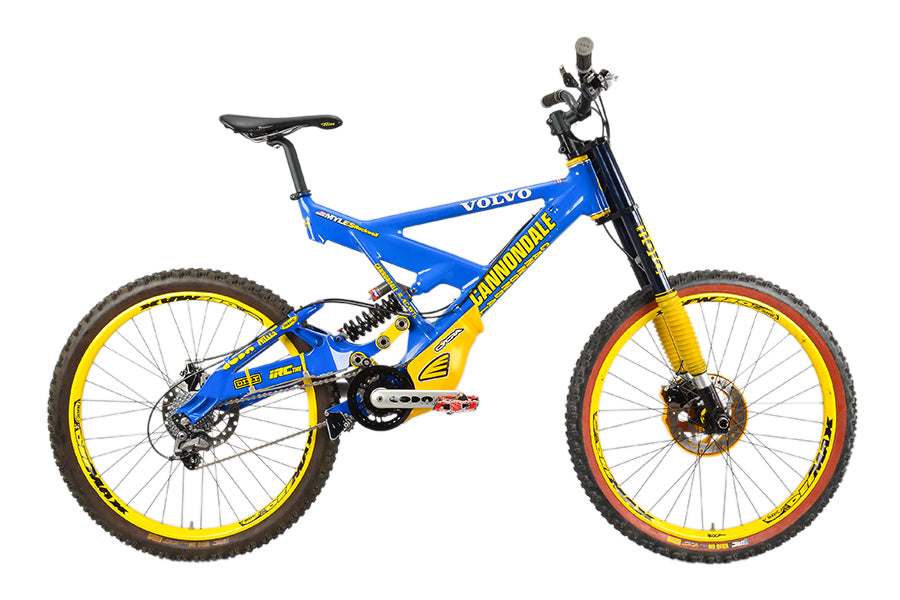
An incredibly advanced full-suspension mountain bike for the time—Cannondale Fulcrum DH. | Image source: TheProsCloset.com
- 1999 – WTB releases the NanoRaptor 29 tire
This tire is regarded as the first commercially available 29er. Big names in mountain biking like Wes Williams, Bob Poor, and Gary Fisher advocated for the large-diameter wheels and petitioned the co-founder of WTB, Mark Slate, to get involved.
- 2002 – Gary Fisher, while working with Trek, releases the first mass-produced 29er mountain bike, the Trek Supercaliber. This line continues today as Trek’s cross-country race bike.
- 2004 – Niner bikes launches as a 29er-only brand
- 2007 – The first 27.5″ mountain bike is unveiled, and Trek introduces the 96er mountain bike with a 29″ front and 26″ rear wheel
At the North American Handmade Bicycle Show, Kirk Pacenti and his builder Kent Eriksen show off the first 27.5″ bike, a custom-made build. The mixed-wheel mountain bike by Trek is the first popularized version of the idea Brian Skinner piloted on his Descender over 20 years before.
- 2012 – SRAM revolutionizes the MTB world with the first mass-produced, mass-marketed 1x mountain bike groupset, the XX1
Many mountain bikers were already riding custom-made single-chainring drivetrains, but SRAM officially took it to market.
- Check out our timeline of the 17 Best MTB-Specific Bike Brands
Origins of Modern Cyclocross
Cyclocross (CX) is an unusual sport. It involves drop-bar racing bikes, mud, snow, sand, and some obstacles riders need to jump or run over while carrying the bike. This unique and exciting mix makes for an entertaining display of athleticism.
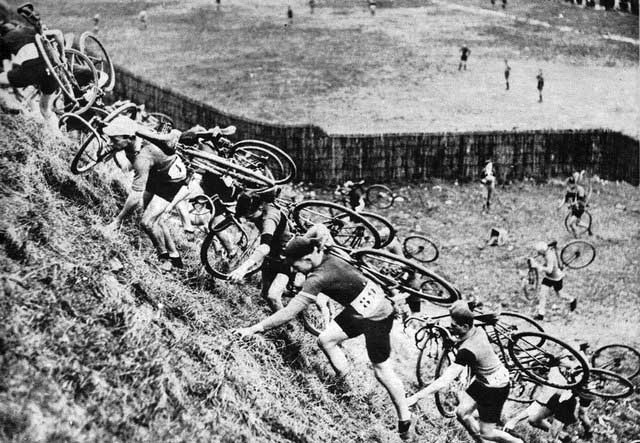
Early cyclocross racers carrying their bikes up a steep hill. | Photo credit: CapoVelo.com
Modern CX involves races of one hour to 90 minutes with multiple laps around a small two to four km circuit. They typically run from fall to the end of winter on courses consisting of soft surfaces that require big efforts to ride across or dismounting to run while carrying the bike.
Cross-country riding and racing is one of the oldest forms of cycling and one of the predecessors of mountain biking.
In recent years, cyclocross has become more popular as road cycling stars such as Wout van Aert, Mathieu van der Poel, Lucinda Brand, and Marianne Vos compete over the winter. However, early CX rides and events may have started as early as the late 1800s.
The Early Development of Cyclocross: 1900 to 1950
The exact origins of cyclocross are unclear. However, in the late 1800s to early 1900s, road cyclists are understood to have practiced CX-style races to maintain fitness through the winter season and improve their bike handling abilities.
These informal events involved racing from town-to-town across fields, muddy roads, and over fences (forcing riders to run while carrying their bikes).
- 1902 – First Cyclocross race is held in France
An army private named Daniel Gousseau organized the first French National Cyclo-Cross Championships, won by Fernand De Baeder. Gousseau would eventually become the secretary-general of the French Cycling Union.
- 1903 – Géo Lefèvre organizes the cross cyclo-pédèstre
Lefevre, one of the key players in the conception of the Tour de France (TdF), organized a CX event in a small town outside of Paris the same year as the first TdF.
- 1910 – Octave Lapize wins the Tour de France, and Belgium has its first National Cyclo-Cross Championships
Lapize credits his TdF win to his off-season CX training, sparking huge interest among European bike racers. Meanwhile, Belgium hosts its first national CX championship, won by Philippe Thys, who later went on to win three Tour de Frances.
- 1912 – First National CX Championship in Switzerland

A cyclo-cross race in Oñati, Basque Country, Spain, in 1947. | Image source: wikipedia.com
- 1923 – First National CX Championship in Luxembourg
- 1924 – Paris hosts the first International Cyclo-Cross race
After proving itself independently across various European countries, cyclocross hit the international stage. The winner of the first international CX event, ‘Critérium international de cross cyclo-pédestre’, was french rider Gaston Degy.
- 1929 – First National CX Championship in Spain
- 1930 – First National CX Championship in Italy
- 1940 – Cycling’s governing body, the UCI, formally recognizes cyclocross as a discipline
The UCI begins regulating the sport and standardizing course designs and equipment for consistency.
Cyclo-Cross After UCI Recognition: 1950s and Onwards
- 1950 – First UCI World Championship held by official regulations in Paris, France
It took ten years for the UCI to host the first World Championships. This event replaced the Critérium International de Cyclo-cross that began in 1924. It was held in January or February in different European countries (until 2013).
- 1963 – First US Cyclo-Cross National Championships held in Palos Park, Illinois

Photo credit: Cyclingnews.com
- 1970 to ’74 – The United States National Cyclo-cross Championships is canceled
- 1975 – National Championships restarts in Berkley, CA
- 2013 – First UCI Cyclo-Cross World Championships held outside of Europe, in Louisville, Kentucky
Sven Nys wins gold in the men’s race, Wout Van Aert earns a bronze medal in the U23s, and Mathieu van der Poel wins the Junior event.
Conclusion
Mountain biking has a rich and complex history filled with a multitude of characters, each one contributing its own piece to the development of the sport and its equipment.

Early mountain bikers posing next to their rudimentary mountain bikes. | Photo credit: mmbhof.org
As we’ve seen, putting your finger on one individual who initiated mountain biking or mountain bike design is almost impossible. Likewise, the original cyclocross riders are equally elusive, but we feel this element of mystery adds to the story’s allure.
The incredible races and technology available today come as a result of thousands of experiments in trial and error and incremental breakthroughs, for which we are eternally grateful.
As Isaac Newton said so long ago, “If I have seen further, it is by standing on the shoulders of Giants.”
Resources:
- MTBR.com
- MBR.co.uk
- Wikipedia.com
- Theproscloset.com
- Sonic.net
- Bikemag.net
- MMBHOF.org
- DirtMountainBike.com


